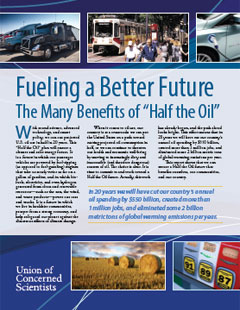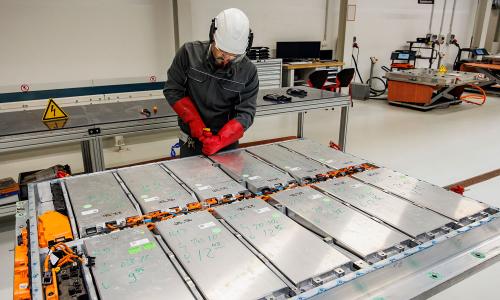When it comes to oil use, our country is at a crossroads: we can put the U.S. on a path toward cutting projected oil consumption in half, or we can continue to threaten our health and economic well-being by moving to increasingly dirty, inaccessible, and dangerous sources of oil.
The choice is clear. It is time to commit to creating a future in which we live in healthier communities, prosper from a strong economy, and help safeguard our planet against the disastrous effects of climate change.
It is time to set the country on a path toward Half the Oil.
Half the Oil and you
- Spending Less on Gas: Transportation is the second-largest expense (after housing) for most American households. Improving the fuel efficiency of passenger vehicles will reduce the amount Americans spend on gas, and is one of the biggest and most immediate consumer benefits of a Half the Oil future.
- Saving Billions on Oil: Reaching a Half the Oil future would cut the total projected consumer spending on oil by $550 billion per year in 2035.
- Increasing Consumer Choice: Consumers will also have greater freedom to choose how their vehicles are powered, including an expanding array of electric vehicles that cost significantly less to fuel than today's average gas-powered vehicle and can save nearly $13,000 in fuel costs over the vehicle's lifetime.
Half the Oil and your community
- Smarter Growth: Reaching a Half the Oil future means continuing to design communities that better integrate transportation options with the places in which we live and work, a set of principles collectively called "smart growth."
- Saving Oil: Working toward smart-growth policies and practices will reduce commute times, make streets safer, clean up our air, revitalize local economies — and yield oil savings of 1.5 million barrels per day in 2035.
- Better Health: Oil-saving technologies will be deployed in communities near ports and other distribution hubs that create heavy traffic, reducing harmful diesel emissions and their associated health impacts, including respiratory illness, asthma, and heart attacks.
Half the Oil and our country
- Creating Jobs: Just through investing in efficiency in cars and trucks, we can create as many as 1 million new U.S.-based jobs, many of which will be directly held by employees of the light- and heavy-duty vehicle and parts-manufacturing industries.
- Stimulating the Economy: Jobs will also be created as consumer spending is shifted from oil to other sectors of the economy that demonstrate a higher potential for job creation compared to the oil and gas industry, thereby stimulating employment, real wages, and state revenues.
- Curbing Climate Change: In a Half the Oil future, we will significantly reduce emissions from the largest source of U.S. global warming emissions today—oil and other petroleum products—to the tune of 2 billion metric tons per year by 2035.
- Stabilizing Markets: Finally, cutting our oil use — and using alternative energy sources not associated with the global energy market — also means that we have an insurance policy against oil price shocks and the dramatic rise in prices and economic impacts that accompany them. For example, an energy source such as electricity can power a vehicle without subjecting families to unpredictable fluctuations in gasoline prices.




